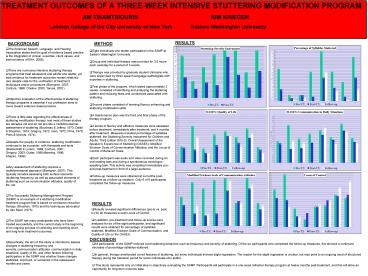TREATMENT OUTCOMES OF A THREEWEEK INTENSIVE STUTTERING MODIFICATION PROGRAM - PowerPoint PPT Presentation
1 / 1
Title:
TREATMENT OUTCOMES OF A THREEWEEK INTENSIVE STUTTERING MODIFICATION PROGRAM
Description:
There is little data regarding the effectiveness of stuttering modification ... will participate in a one-week refresher therapy program at twelve months post ... – PowerPoint PPT presentation
Number of Views:79
Avg rating:3.0/5.0
Title: TREATMENT OUTCOMES OF A THREEWEEK INTENSIVE STUTTERING MODIFICATION PROGRAM
1
TREATMENT OUTCOMES OF A THREE-WEEK INTENSIVE
STUTTERING MODIFICATION PROGRAM JIM
TSIAMTSIOURIS KIM KRIEGER
Lehman College of the City University of New
York Eastern Washington University
- BACKGROUND
RESULTS
METHOD
- The American Speech, Language, and Hearing
Association states that the goal of evidence
based practice is the integration of clinical
expertise, client values, and best evidence
(ASHA, 2008). - There are numerous intensive stuttering therapy
programs that treat adolescent and adults who
stutter, yet best evidence for treatment outcomes
remain relatively rare despite calls for the
verification of treatment techniques and/or
procedures (Blomgren, 2007 Conture, 1996
Onslow, 2003 Yaruss, 2001). - Objective evaluation of the effectiveness of
stuttering therapy programs is essential if our
profession aims to move toward evidence based
practice. - There is little data regarding the effectiveness
of stuttering modification therapy, and most of
these studies are decades old and do not provide
a multidimensional assessment of stuttering
(Boudreau Jeffrey, 1973 Dalali Sheehan,
1974 Gregory, 1972 Irwin, 1972 Prins, 1970 - Prins Nichols, 1974).
- Despite the paucity of evidence, stuttering
modification continues to be a popular with
therapists and texts (Breitenfeldt Lorenz,
1989 Conture, 2001 Gregory, 2003 Guitar,
1998Manning, 1996 Shapiro, 1999). - Any assessment of stuttering requires a
multidimensional approach (Blomgren, 2007). This
typically includes assessing both surface
elements (stuttering frequency) as well as
associated elements of stuttering such as
communication attitudes, quality of life, etc. - The Successful Stuttering Management Program
(SSMP) is an example of a stuttering modification
treatment program that is based on avoidance
reduction therapy (Sheehan, 1970) and the
techniques advocated by Van Riper (1973).
- Eight individuals who stutter participated in the
SSMP at Eastern Washington University. - Group and individual therapy was provided for 3.5
hours each weekday for a period of 3 weeks. - Therapy was provided by graduate student
clinicians who were supervised by three
speech-language pathologists with expertise in
stuttering. - First phase of the program, which lasted
approximately 2 weeks, consisted of identifying
and analyzing the stuttering pattern and reducing
fears and avoidances associated with stuttering. - Second phase consisted of learning fluency
enhancing and stuttering modification skills. - A maintenance plan was the third and final phase
of the therapy program. - A series of fluency and affective measures were
assessed before treatment, immediately after
treatment, and 4 months after treatment. Measures
included percentage of syllables stuttered the
Stuttering Severity Instrument for Children and
Adults, Third Edition (SSI-3) Overall Assessment
of the Speakers Experience of Stuttering
(OASES) Modified Erickson Scale of Communication
Attitudes and the Locus of Control of Behavior
Scale. - Each participant was audio and video recorded
during an oral reading task and during a
spontaneous monologue speaking task. This
activity was completed immediately pre- and
post-treatment in front of a large audience. - Follow-up measures were obtained at 4-months
post-treatment as a follow-up measure. Only 6 of
8 participants completed the follow-up measures.
RESULTS
- Results revealed significant differences (pre-tx
vs. post-tx) for all measures except Locus of
Control. - In addition, pre-treatment and follow-up scores
were analyzed for six of the eight participants,
and significant results were obtained for
percentage of syllables stuttered, Modified
Erickson Scale of Communication, and Quality of
Life on the OASES.
DISCUSSION
- All participants of the SSMP reduced overt
stuttering behaviors such as frequency and
severity of stuttering. Of the six participants
who completed the follow-up measures, five showed
a continued decrease of percentage syllables
stuttered. - In general, therapy ameliorated covert features
of stuttering, but some individuals showed slight
regression. The reason for the slight regression
is unclear, but may point to an ongoing need of
structured therapy during the transition period
for some individuals who stutter. - This study represents only an initial step in
objectively evaluating the SSMP. Participants
will participate in a one-week refresher therapy
program at twelve months post-treatment, and this
will allow an opportunity for long-term outcome
data.































